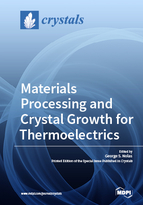Materials Processing and Crystal Growth for Thermoelectrics
A special issue of Crystals (ISSN 2073-4352). This special issue belongs to the section "Inorganic Crystalline Materials".
Deadline for manuscript submissions: closed (31 July 2017) | Viewed by 55045
Special Issue Editor
Interests: structure–property relationships and thermal properties of materials; the effect of structural and chemical variations on the transport, optical, and magnetic properties of materials
Special Issues, Collections and Topics in MDPI journals
Special Issue Information
Dear Colleagues,
Due to formidable synthetic challenges, many materials of scientific and technological interest are not readily accessible. Often poor quality materials, due to the difficulty in preparation of such materials in high purity and high yield, results in erroneous interpretations of their observed physical, and sometimes structural properties. New or improved processing techniques are crucial in order to investigate the intrinsic properties of new and novel materials and elucidate their fundamental physical properties in order to apply them to technologically important applications. One of the important technological challenges today is energy sustainability. Increasing awareness and concern for energy resources and the environment has stimulated advances in materials for energy conversion and refrigeration in recent years. Thermoelectrics offer the possibility of an all-solid-state technology for power conversion, refrigeration, temperature stability and temperature control. In many cases, modifications of the processing conditions allow for modifications of the transport properties, thus providing an avenue for “tuning” of the thermoelectric properties. Cost effective scale-up is also of interest for eventual mass-production processing.
The Special Issue on “Materials Processing and Crystal Growth for Thermoelectrics” is intended to provide a unique international forum aimed at covering a broad description of results involved with the processing and crystal growth of thermoelectric materials, as well as physical properties characterization needed in order to understand the important influences materials processing has on the properties of materials. Scientists working in a wide range of disciplines are invited to contribute to this special issue.
The topics summarized by the keywords broadly cover some of the different examples of sub-topics.The volume is, however, open for contributions involving all aspects of the different processing techniques and new material developments for thermoelectric applications.
Prof. George S. Nolas
Guest Editor
Manuscript Submission Information
Manuscripts should be submitted online at www.mdpi.com by registering and logging in to this website. Once you are registered, click here to go to the submission form. Manuscripts can be submitted until the deadline. All submissions that pass pre-check are peer-reviewed. Accepted papers will be published continuously in the journal (as soon as accepted) and will be listed together on the special issue website. Research articles, review articles as well as short communications are invited. For planned papers, a title and short abstract (about 100 words) can be sent to the Editorial Office for announcement on this website.
Submitted manuscripts should not have been published previously, nor be under consideration for publication elsewhere (except conference proceedings papers). All manuscripts are thoroughly refereed through a single-blind peer-review process. A guide for authors and other relevant information for submission of manuscripts is available on the Instructions for Authors page. Crystals is an international peer-reviewed open access monthly journal published by MDPI.
Please visit the Instructions for Authors page before submitting a manuscript. The Article Processing Charge (APC) for publication in this open access journal is 2600 CHF (Swiss Francs). Submitted papers should be well formatted and use good English. Authors may use MDPI's English editing service prior to publication or during author revisions.
Keywords
- materials processing for thermoelectrics
- crystal growth and synthetic routes
- structure-property and processing-property relationships
- transport properties
- mechanical properties






